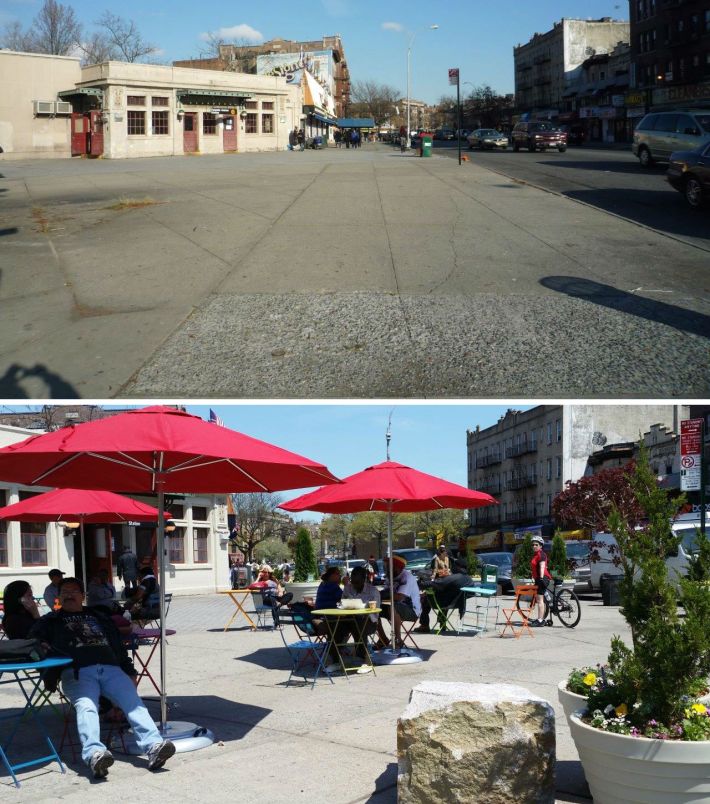There are two dueling visions of public space in New York City. On one side, tabloid columnists and the police commissioner believe that any problems encountered in Midtown's public spaces -- whether homeless men or hustling desnudas -- should be fixed by replacing space for people with good old-fashioned car traffic. On the other side are residents and advocates working hard to improve public space in communities across the city, using shoestring budgets and their own street smarts.

The people who want to rip out Manhattan's public space have gotten a lot of attention in the past month. This story is about the people working to make the rest of New York City's public spaces better.
Yesterday, ioby ("in our backyards") -- a non-profit founded in 2009 that marries crowdfunding with community organizing -- hosted an event highlighting outer-borough public space success stories from Flatbush to Cypress Hills to Astoria. The projects include community gardens, street festivals, streetscape improvements, and plazas. Ioby acts as a fundraising tool, and sometimes a financial sponsor, for local groups who do the hard work of organizing residents and pushing government bureaucracies into action. The result: Public spaces that better serve neighborhood needs.
The projects all transformed spaces that had been underutilized or unattractive. In Prospect-Lefferts Gardens, a wide but barren sidewalk at an intersection outside the Parkside Avenue subway station got tables, chairs, and plantings from the DOT plaza program -- but it was up to local residents to fund maintenance. They turned to the Neighborhood Plaza Partnership and ioby to raise funds to support the plaza.
Residents had been trying to attract a farmers market to the corner for years, plaza designer and local resident In Cho said, but market operators feared it wouldn't succeed in such an unattractive place. Getting the sidewalk furniture helped change perceptions. With the new planters and seating (and another assist from DOT, which repaired a cracked section of the sidewalk that had been ignored for years), a farmers market now sets up shop every Sunday.
Today, the plaza is a neighborhood gathering spot at the southeast corner of Prospect Park. “It's literally trees, benches, and umbrellas. It’s not much," Cho said. “What really encouraged everyone was that there was this pride in the place.”
Sheryll Durrant, who directs urban farm and garden programs for Sustainable Flatbush, had a similar experience after raising funds to replace an overgrown lot with a medicinal herb garden based on expertise from the neighborhood's West Indian and Tibetan immigrants. “I am amazed at how these projects develop and the wealth of knowledge that’s in our community," she said. “It put us on the map in a much bigger way so that other organizations started to reach out to us."
On Fourth Avenue in Park Slope, ongoing renovations at the elevated 9th Street train station left locals frustrated with empty MTA-owned storefronts, construction equipment, and a lack of communication from the transit agency. That's when Grace Freedman and SJ Avery turned their attention to the space as part of the Forth on Fourth initiative, a program of the Park Slope Civic Council.
After raising funds for a temporary art installation to show how the sidewalks beneath the elevated station could be more inviting, the group got the MTA to engage with local residents about the construction work. "Doing the community organizing brought a new energy and new people to what we were doing," Freedman said. "The fact that we raised money, though, completely changed the way people treated us." Now, the group is working with the MTA on a second art installation in the empty storefronts beneath the elevated train.
In addition to the success stories, participants at yesterday's event stressed that public spaces don't always conform to an idyllic notion of what they should be -- and local leaders have to be prepared for that.
"Because it's an open public space, everyone is welcome there, and that includes the people in our neighborhoods that we cast away, which is not always pretty or beautiful," said Dorothy Le, director of capacity building at the Neighborhood Plaza Partnership. "And in that way, public spaces sort of shine a light to what we as a society condone or don't condone and how we treat the least privileged members of our society.”
"A homeless person needs a place to sit next to a family that needs a place for their kids to play hide-and-seek," said NPP Managing Director Laura Hansen. "In neighborhoods that don’t have resources, they have to grapple with that in a much more real way than, say, a public space in Manhattan that has a lot of money to throw at security and programming."





